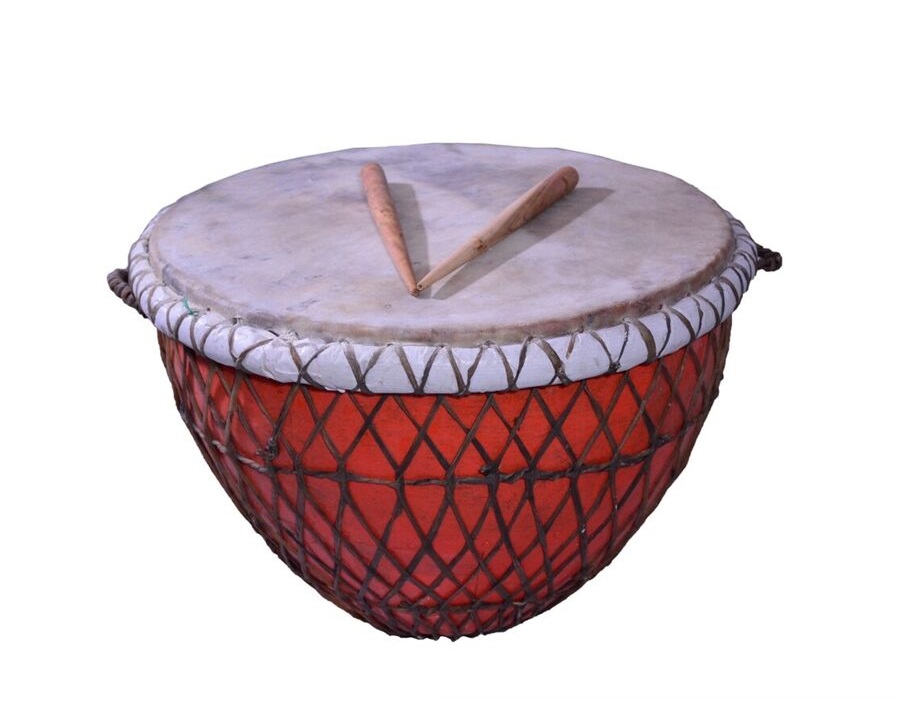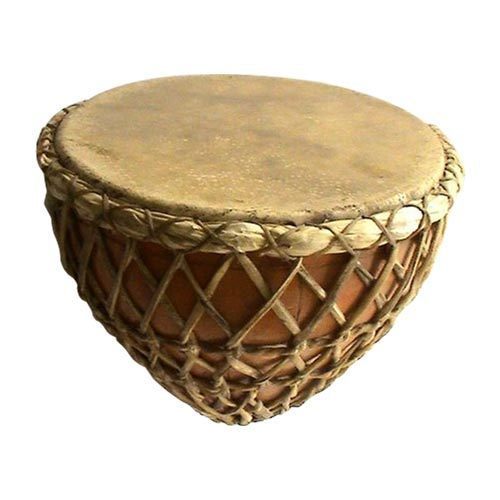Nagada
Percussions
Asia
Ancient
Video
The Naqareh, also known as Naqqāra, Nagara, or Nagada, is a traditional Middle Eastern percussion instrument characterized by its distinctive rounded back and hide head. This double drum is typically played in pairs, with each drum producing different pitches—one for high and the other for low tones.
It is classified as a membranophone, specifically a kettle drum, and plays a significant role in various musical traditions across Iran and other regions. The Naqareh is primarily a percussion instrument. Its design includes two drums of varying sizes, allowing for a versatile sound range. The larger drum produces higher-pitched sounds while the smaller one generates deeper tones. The instrument is often mounted on a stand for ease of play but can also be tied to animals during performances or ceremonies.
History and Origin
The nagada, also spelled as “nagara” or “naqqara,” is one of the oldest percussion instruments in the world. Originating in the Indian subcontinent, this kettle-shaped drum has been an integral part of cultural and musical traditions for centuries. The instrument’s roots can be traced back to the 14th century when it gained prominence in both royal courts and religious ceremonies. The nagada is believed to have traveled through the Middle East and Central Asia, eventually becoming a key feature in Persian, Turkish, and Indian music traditions. Its name derives from the Arabic word “naqqāra,” meaning “drum,” highlighting its widespread influence and historical significance.
Historically, the nagada was used to announce the arrival of royalty, signal the start of a battle, or accompany spiritual rituals. Its booming sound made it an ideal instrument for open spaces, where its resonance could be heard over long distances. Over time, it transitioned from a functional tool of communication to an essential element of music and dance, particularly in folk traditions.
Construction
The nagada is typically constructed from natural and locally available materials, which vary depending on the region. The body of the drum is made from a hollowed-out piece of wood, metal, or clay, giving it a robust and resonant structure. The drumhead is crafted from stretched animal hide, usually goat or buffalo skin, which is tightly secured around the rim using leather straps or metal rings. The drumhead’s tension is adjustable, allowing players to modify the pitch and tone according to their preferences.
The nagada’s kettle-shaped body amplifies its deep, resonant sound, making it an ideal instrument for outdoor performances. The size of the nagada can vary significantly, ranging from small handheld drums to large floor-standing ones. The larger the drum, the deeper and more powerful the sound it produces. Some modern versions of the nagada incorporate synthetic materials for durability and enhanced acoustic performance.
Types of Nagada
There are several types of nagada, each adapted to specific cultural or musical contexts:
Classical Nagada: Used in traditional Indian music, particularly in Dhrupad and Kathak performances. These are medium-sized drums that produce a balanced and melodic tone.
Folk Nagada: Common in rural areas, these are larger and produce a louder, earthier sound, ideal for folk dances and festivals.
Battle Nagada: Historically used in military contexts, these are large drums designed to create powerful, resonating beats that could be heard over long distances.
Temple Nagada: Played during religious rituals and temple ceremonies, these are often elaborately decorated and produce a solemn, spiritual sound.
Modern Nagada: Incorporating synthetic materials and contemporary designs, these are used in fusion music and stage performances for a modern twist on the traditional instrument.
Features
- Kettle Shape: The distinct shape of the nagada enhances its acoustic properties, allowing it to produce a deep, resonant sound.
- Adjustable Tension: The drumhead tension can be modified to achieve different tones and pitches.
- Durable Materials: Traditional nagadas are made from natural materials, while modern versions may use synthetic components for added durability.
- Versatility: The nagada is used in a wide range of settings, from religious ceremonies to large-scale musical performances.
- Rich Tonal Quality: The instrument’s deep, booming sound creates a dramatic auditory experience, often serving as the backbone of rhythmic compositions.
Sound Production
The nagada produces sound through the vibration of its drumhead when struck. The stretched animal hide acts as a membrane that resonates when hit with sticks or hands, generating sound waves. The kettle-shaped body amplifies these sound waves, creating a powerful, booming tone. The pitch and tonal quality can be adjusted by varying the tension of the drumhead or the force of the strikes.
Skilled players can produce a range of sounds, from sharp, high-pitched beats to deep, thunderous rhythms. This versatility allows the nagada to adapt to various musical styles and performance contexts. The instrument’s unique tonal quality makes it an essential component of traditional music, where it often serves as a rhythmic anchor.
Playing Methods
The nagada is typically played using wooden sticks, though some styles involve striking the drumhead with the hands. The instrument is usually positioned on the ground or mounted on a stand, with the player seated or standing nearby. Players use one or two sticks to strike the drumhead, creating rhythmic patterns that vary in speed and complexity.
In traditional ensembles, the nagada is often paired with other percussion instruments, such as the shehnai or tabla, to create dynamic and engaging performances. The rhythm produced by the nagada often dictates the pace and mood of the accompanying music, making it a crucial element in ensemble settings.
Roles in Music
The nagada plays a vital role in various musical traditions, both as a solo instrument and as part of larger ensembles. In folk music, it provides the driving rhythm for dances and celebrations, creating an energetic and festive atmosphere. In classical music, the nagada is used to complement melodic instruments, adding depth and complexity to the composition.
In religious contexts, the nagada is played during temple rituals and processions, where its booming sound is believed to invoke divine blessings and create a spiritual ambiance. In theatrical performances, such as traditional Indian dramas or dance recitals, the nagada enhances the dramatic impact by accentuating key moments with its powerful beats. In modern music, the nagada has found a place in fusion genres, where it is combined with electronic and Western instruments to create innovative sounds. Its versatility and rich tonal quality make it a popular choice for experimental music and cross-cultural collaborations.
The nagada’s enduring appeal lies in its ability to adapt to different musical styles and cultural contexts. From its ancient origins to its contemporary applications, the nagada continues to captivate audiences with its powerful and evocative sound.
FAQ
What is the cultural significance of the Nagada?
The Nagada holds immense cultural value as it is used in religious rituals, folk music performances like Bhangra, and traditional dances such as Chhau. Historically, it was also employed as a war drum to signal armies or announce royal events.
Where did the Nagada originate?
The Nagada originated in the Middle East and was introduced to India during the medieval period by Arabs and Persians. Over time, it became deeply rooted in Indian culture through temple rituals and folk traditions.
How is a Nagada constructed?
A Nagada consists of a rounded body made from materials like metal or clay and a drumhead crafted from animal hide. The skin is stretched tightly over the body using leather straps or cords to produce its distinct sound.
 Links
Links
References
Other Instrument
Categories



















